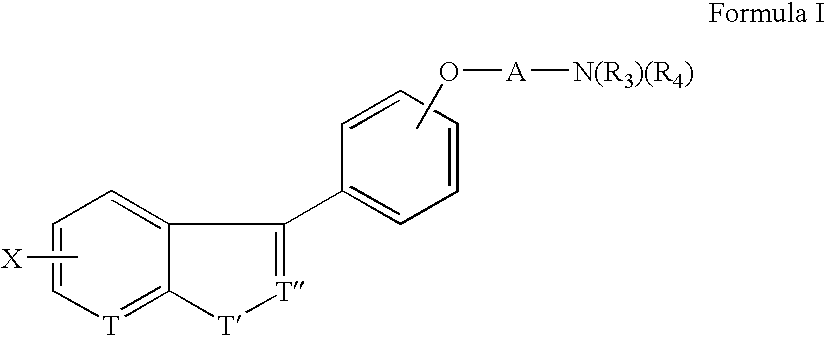Benzisoxazolyl-,pyridoisoxazolyl-and benzthienyl-phenoxy derivatives useful as D4 antagonists
a technology of pyridoisoxazolyl and benzthienylphenoxy, which is applied in the field of benzisoxazolyl, pyridoisoxazolyland benzthienylphenoxy derivatives useful as d4 antagonists, can solve the problems of not meeting the criteria, not being able to meet the requirements of the normalization process, and not being able to achieve the normalization process
- Summary
- Abstract
- Description
- Claims
- Application Information
AI Technical Summary
Problems solved by technology
Method used
Image
Examples
example 1
MDL 814608A
Synthesis of 6-fluoro-3-[4-(3-piperidin-1-yl-propoxy)-phenyl]-benzo[d]isoxazole hydrochloride (Scheme IV, Compound 1c)
Scheme IV, Step S
Synthesis of 1-(3-phenoxy-propyl)-piperidine (Scheme IV, Compound 4)
[0148]
[0149] Mix 3-phenoxypropyl bromide (801.5 g, 3.73 mol), potassium iodide (61.8 g, 0.37 mol, 0.10 equivalents) and water (4.0 L) in a 12-L, 3-necked flask fitted with: a stirrer, thermometer in a side-arm adapter, connected to a Firestone® valve and an addition funnel fitted with a gas outlet adapter, connected to a bubbler. Add piperidine (634.6 g, 7.45 mol, 2.0 equivalents) over 1 hour, without cooling under nitrogen. The temperature at the end of the addition is 40° C. Heat the reaction mixture and maintain the temperature at 50° C. for 6 hours. Monitor the progress of the reaction by HPLC (Column=300×3.9 mm Phenomenex Bondclone 10 CN; mobile phase=65% acetonitrile:35% 0.1N ammonium formate buffer; flow=1.5 mL / minute; wavelength=215 nm; RT: 3-phenoxypropyl brom...
example 2
MDL 813866
Synthesis of (S)-1-[4-(6-fluoro-benzo[d]isoxazol-3-yl)-phenoxy]-3-[(thiophen-3-ylmethyl)-amino]-propan-2-ol maleate (Scheme III, Compound 1 and Scheme V, Compound 1e)
Scheme I, Step D and Scheme V, Step W
Synthesis of (2,4-difluoro-phenyl)-(4-methoxy-phenyl)-methanone (Scheme I, Compound and Scheme V, Compound 4)
[0155]
[0156] Combine 2,4-difluorobenzoyl chloride (227.8 g, 1.29 mol), anisole (154.2 mL, 1.42 mol) and 1,2-dichloroethane (2.28 L) and cool (−3° C.) under a nitrogen atomosphere. Add aluminum chloride (209.8 g, 1.57 mol) over 45 minutes. The solution color turns from clear to yellow. Pour the reaction mixture over a mixture of ice (1700 g) and concentrated HCl (640 mL) over 2 minutes. The color of the mixture turns from yellow to clear. Separate layers and wash organic layer with 10% potassium carbonate (1600 mL), water (1600 mL), dry (MgSO4), filter and concentrate to give a solid. Stir the solid in heptane (960 mL) and filter to give the title compound as a wh...
example 2a
Synthesis of thiophen-3-yl-methylamine (Scheme V, Compound 12)
Scheme V, Step B′
Synthesis of thiophene-3-carbaldehyde oxime (Scheme V, Compound 11)
[0173]
[0174] Dissolve hydroxylamine hydrochloride (725 g, 10.43 mol) in pyridine (3 L), which causes an exotherm (23-30° C.). Cool (25° C.) the reaction mixture, under nitrogen and add 3-thiophenecarboxaldehyde (585 g, 5.2 mol) over ˜1 hour while maintaining the temperature from 22-27° C. Concentrate (60° C. / 50 torr) the reaction mixture to an oily residue and partition between ethyl acetate (2 L) and water (1 L). Extract the organic layer with 1 N HCl (2×600 mL), followed by water (3×500 mL). Dry (MgSO4), filter, wash the solid with ethyl acetate (500 mL) and concentrate (60° C. / 60 torr) to give the title compound as a semi-solid residue (575 g, 99% Yield: 1H NMR (CDCl3, 200 MHz) δ 7.3-7.55 (m, 3H), 8.2 (s, 1H), 8.7-9.2 (br s, 1H).
Scheme V, Step C′
Synthesis of thiophen-3-yl-methylamine (Scheme V, Compound 12)
[0175]
[0176] Add a solutio...
PUM
| Property | Measurement | Unit |
|---|---|---|
| Disorder | aaaaa | aaaaa |
Abstract
Description
Claims
Application Information
 Login to View More
Login to View More - R&D
- Intellectual Property
- Life Sciences
- Materials
- Tech Scout
- Unparalleled Data Quality
- Higher Quality Content
- 60% Fewer Hallucinations
Browse by: Latest US Patents, China's latest patents, Technical Efficacy Thesaurus, Application Domain, Technology Topic, Popular Technical Reports.
© 2025 PatSnap. All rights reserved.Legal|Privacy policy|Modern Slavery Act Transparency Statement|Sitemap|About US| Contact US: help@patsnap.com



